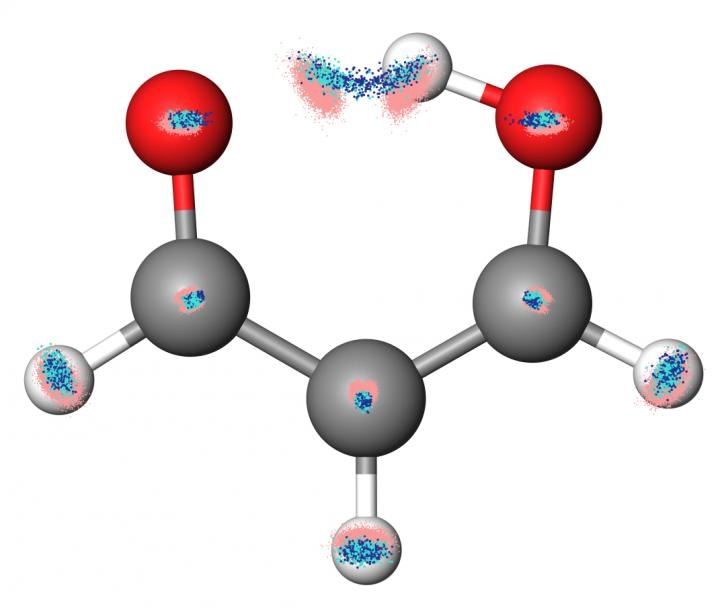Oct 12 2017
A new machine-learning method has been developed by an international, interdisciplinary research team of Scientists. This method is capable of predicting molecular behavior and is considered to be a breakthrough that can help in the development of pharmaceuticals and the design of new molecules that have the potential for improving the performance of emerging battery technologies, digital displays and solar cells.
 A new learning algorithm is illustrated on a molecule known as malonaldehyde that undergoes an internal chemical reaction. The distribution of red points corresponds molecular configurations used to train the algorithm. The blue points represent configurations generated independently by the learning algorithm. The turquoise points confirm the predictions in an independent numerical experiment. CREDIT Image courtesy of Leslie Vogt.
A new learning algorithm is illustrated on a molecule known as malonaldehyde that undergoes an internal chemical reaction. The distribution of red points corresponds molecular configurations used to train the algorithm. The blue points represent configurations generated independently by the learning algorithm. The turquoise points confirm the predictions in an independent numerical experiment. CREDIT Image courtesy of Leslie Vogt.
The work has been published in the journal Nature Communications.
By identifying patterns in molecular behavior, the learning algorithm or 'machine' we created builds a knowledge base about atomic interactions within a molecule and then draws on that information to predict new phenomena.
Mark Tuckerman, a Professor of Chemistry and Mathematics, New York University and one of the paper's Primary Authors
Klaus-Robert Müller of Berlin's Technische Universität (TUB) and the University of California Irvine's Kieron Burke were the other Primary Authors of the paper.
The work incorporates innovations in machine learning with chemistry and physics. Data-driven approaches, especially in the field of machine learning, permit daily devices to learn automatically from limited sample data and, consequently, to act on fresh input information. Such approaches have changed how common tasks, such as text analysis, image recognition, language translation and online searching, are carried out.
In recent years, related development has taken place in the natural sciences, with efforts directed on materials science, molecular design and engineering. However, machine-learning approaches in these areas have mostly not explored the development of methodologies - tools capable of advancing science in ways that have already been attained in public safety and banking.
The Researchers have developed a machine that has the potential to learn difficult interatomic interactions, which are generally prescribed by complex quantum mechanical calculations, without the need for performing such intricate calculations.
While constructing their machine, the Researchers developed a tiny sample set of the molecule they desired to study in order to train the algorithm and then made use of the machine for simulating complex chemical behavior within the molecule.
As an illustrative example, they selected a chemical process that happens inside a simple molecule called malonaldehyde. In order to weigh the viability of the tool, the team analyzed how the machine predicted the chemical behavior and went on to compare their prediction with the existing chemical understanding of the molecule. How much the machine could learn from the limited training data provided to it was demonstrated by the results obtained.
Now we have reached the ability to not only use AI to learn from data, but we can probe the AI model to further our scientific understanding and gain new insights.
Klaus-Robert Müller, Professor for Machine Learning, Technical University of Berlin
For the very first time, an online video demonstrates a chemical process that was modeled by machine learning - a proton transferring inside the malonaldehyde molecule.